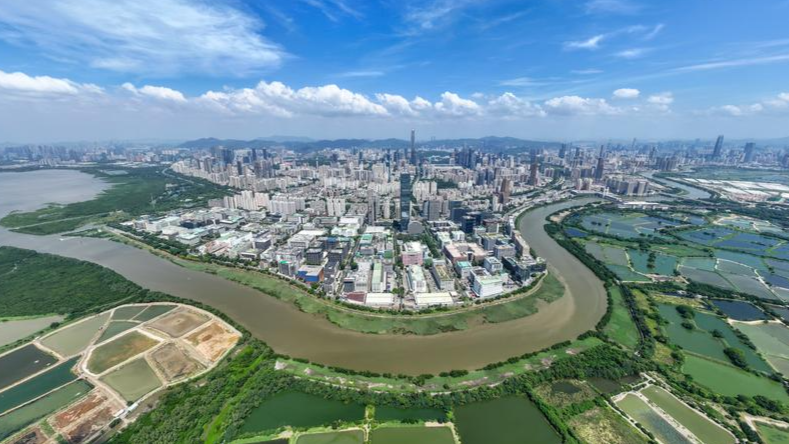
Accelerated integration of the services trade in the Guangdong-Hong Kong-Macao Greater Bay Area will propel the region’s industrial upgrading and help China gain strategic advantages in global trade, experts said.
Their remarks came after the country released recommendations for the 15th Five-Year Plan (2026-30) last month, which mapped out its development blueprint over the coming five years.
The document suggested boosting the development of trade in services by encouraging exports, refining the negative list-based management system for cross-boundary trade and improving standards.
As the country’s foreign trade powerhouse, the Greater Bay Area, which consists of nine cities in Guangdong province plus the Hong Kong and Macao special administrative regions, has seen robust development in trade in goods over the past years. Trade in services, meanwhile, has been overshadowed, which experts say needs to be enhanced by promoting cross-boundary integration.

According to official statistics, Guangdong’s services trade only accounted for 12.5 percent of its total trade in 2024, 12 percentage points lower than the global average level and two percentage points lower than the national average level.
Guangdong boasts a solid foundation in the goods trade, but it grapples with an imbalance — the prioritizing of tangible goods over the services and digital sectors — said Gong Xiaofeng, director of the Greater Bay Area emerging industry development research institute at Shenzhen University.
ALSO READ: Digital economy holds key to ensuring stability, long-term prosperity
“The province should develop a matching modern producer service system to bridge the gap between the growth of advanced manufacturing and lagging services,” he said.
Guangdong has been stepping up efforts to expand openness for Hong Kong and Macao service providers over the past years with major progress having been made, but there is still ample room for improvement in terms of regional integration.
“The integration of trade in services in the Greater Bay Area is of great significance,” said Guo Wanda, executive vice president of Shenzhen-based think tank China Development Institute.
“On the one hand, China has remained committed to advancing institutional opening-up, which centers on opening-up in standards, rules and governance. The Greater Bay Area, as a pilot zone and forerunner of such institutional opening-up, bears significant implications for the country’s overall drive in this regard. On the other hand, such integration can promote industrial upgrading and the free flow of various factors of production within the region.”
READ MORE: GBA spearheads nation’s ‘unicorn’ growth
Dai Zhipeng, assistant professor of Faculty of Economics at Shenzhen MSU-BIT University, believes the integration of trade in services in the Greater Bay Area is a crucial step for the country to gain a strategic initiative in the new round of global free trade.
“By leveraging the region’s advantages through platform coordination, the flow of factors, a complete industrial chain of R&D, production and sales can be formed, facilitating the country’s transformation from ‘goods export’ to ‘service export’ and enhancing its international competitiveness,” he said.
Against the backdrop of global value chain restructuring and rising manufacturing costs, the services trade is playing an increasingly important role in China’s foreign trade development. According to government data, China’s services trade volume broke the $1 trillion mark for the first time last year, posting a 13.2 percent year-on-year increase and accounting for 14.6 percent of the country’s total foreign trade — 2.2 percentage points higher than the 2020 level.

Guo pointed out that the key challenge with the regional integration of the services trade lies in the lack of alignment in rules and standards across the Greater Bay Area. He highlighted the importance of two-way opening-up.
“The nine mainland cities in the Greater Bay Area are widening their doors to Hong Kong and Macao in terms of professional qualifications, digital payment, travel, etc. Ideally, a two-way opening-up mechanism should be established in the long run.”
He added that priority should be given to advancing alignment in specific sectors. “More efforts should be made to accelerate the opening-up of rules and standards in industrial sectors. The liberalization of such rules and standards that drive industrial development will smooth the progress of Greater Bay Area integration.”
Dai stressed that aligning institutional rules is the key to unblocking the region’s service trade integration, with the rollout of a streamlined cross-boundary services negative list as a critical breakthrough.
“Full enforcement of national treatment for Hong Kong and Macao service providers and removal of non-negative-list restrictions will unlock cross-boundary factor flows and deepen regional cooperation,” he said.
Gong, meanwhile, emphasized that complementary synergy, rather than homogeneity, is the core for the integration.
He suggested that three steps be taken to push forward with the drive: unifying industrial and supply chains to boost enterprise coordination, integrating the full lifecycle from R&D to talent allocation, and standardizing norms to smooth trade liberalization and facilitation.
Contact the writer at sally@chinadailyhk.com


